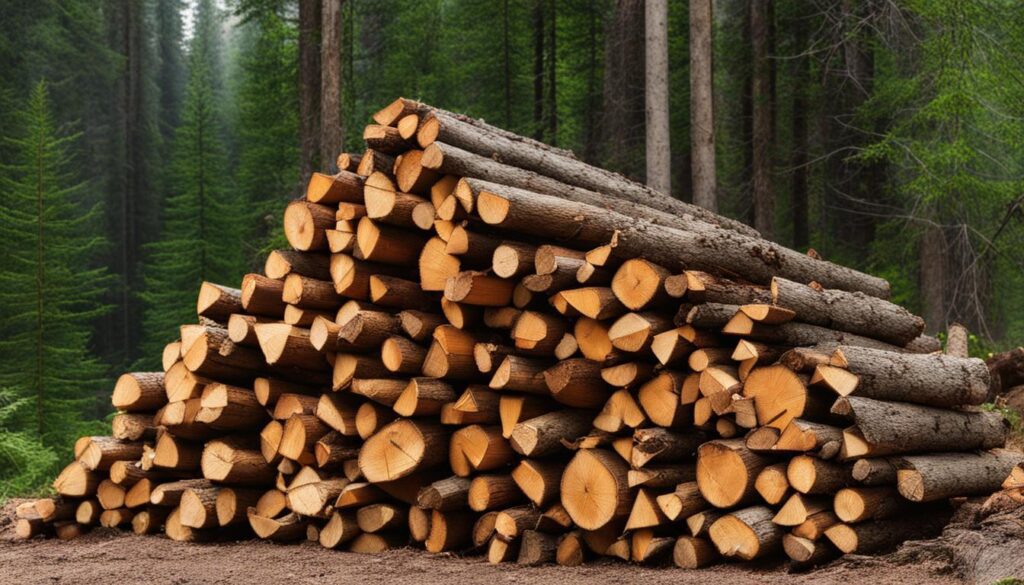If you’re in search of firewood that combines excellent burning properties with unique benefits, mulberry firewood might be the perfect choice for you. Mulberry is known for its high heat output and long-burning coals, making it a preferred option for heating and cooking purposes.
When burned, mulberry firewood emits 25.8 million BTUs per cord, placing it in the league of high-quality woods like red oak and maple. This substantial heat output allows for efficient heating in wood stoves and fireplaces, ensuring a cozy environment. The smoky and sweet aroma produced by mulberry firewood enhances the overall ambiance and is especially delightful for slow-cooking meat or creating a cozy atmosphere during camping trips.
Mulberry firewood has the added benefit of being relatively low in sap and resin, resulting in minimal creosote build-up in chimneys. This factor not only contributes to better indoor air quality but also reduces the frequency of chimney cleaning. Additionally, mulberry firewood is easy to split and produces long-burning coals, making it a convenient choice for firewood users.
However, it’s worth noting that mulberry firewood does produce more sparks and smoke compared to some other firewood options. This can be mitigated through proper seasoning, ensuring the wood is adequately dried before use.
In conclusion, mulberry firewood offers a range of burning properties and benefits that make it an attractive choice for heating, cooking, and creating a cozy ambiance. Despite its tendency to produce more sparks and smoke, proper seasoning and responsible usage can minimize any associated issues. Consider mulberry firewood for your next firewood purchase, and enjoy its high heat output, long-burning coals, and pleasant aroma.
Mulberry Firewood: Heat Output and Comparison to Other Firewood Types
Mulberry firewood is known for its impressive heat output, emitting 25.8 million BTUs per cord. This places it in the same league as high-quality firewood options like bur oak, maple, apple, and beech in terms of heat production. When compared to other common firewood types, mulberry outperforms alder, aspen, chestnut, and white fir, delivering much higher heat levels.
To provide a comprehensive comparison, here is a table showcasing the heat output (in million BTUs per cord) of mulberry firewood along with various other firewood types:
| Firewood Type | Heat Output (BTUs) |
|---|---|
| White fir | 14.6 |
| Alder | 17.5 |
| Chestnut | 18.0 |
| Aspen | 18.2 |
| Maple | 25.5 |
| Mulberry | 25.8 |
| Bur oak | 26.2 |
| Apple | 27.0 |
| Beech | 27.5 |
As you can see, mulberry firewood is on par with other high-quality firewood varieties when it comes to heat output, offering exceptional warmth and efficiency for your fireplace or wood stove.
Mulberry Firewood: Smoke, Splitting, Sparks, and Aroma
Mulberry firewood offers a unique combination of characteristics when it comes to smoke, splitting, sparks, and aroma. Let’s explore each aspect in detail:
Smoke
When burned, mulberry firewood produces a moderate amount of smoke. While it may not be as clean-burning as woods like ash or cherry, the smoke output is lower compared to options like Douglas fir and some types of pine. This makes mulberry firewood a suitable choice for those who enjoy the ambiance of a crackling fire while minimizing smoke-related issues.
Splitting
Mulberry wood typically has a straight grain, making it easy to split. With proper tools and technique, you can efficiently split mulberry logs into smaller pieces for your fire. However, it’s worth noting that logs with knots may require a bit more effort to split evenly.
Sparks
While mulberry firewood is known for its excellent burning properties, it does have a tendency to produce more sparks and popping compared to other firewood options. This characteristic makes it important to exercise caution when burning mulberry wood, particularly in open-air fireplaces or areas with a high fire risk.
Aroma
The aroma of burning mulberry wood is smoky and sweet, adding to the overall experience of using it as firewood. While the scent may not be as pronounced as woods like hickory or apple, the smoky aroma provides a pleasant backdrop for outdoor gatherings or creating a cozy atmosphere around a campfire.
Conclusion: Pros and Cons of Using Mulberry Firewood
Mulberry firewood offers several advantages for your heating and recreational needs. It boasts a high heat output, allowing for efficient warming of your living space or outdoor area. The long-burning coals ensure a sustained and cozy fire, perfect for extended periods of relaxation.
One of the notable benefits of mulberry firewood is its pleasant aroma. The smoky and sweet fragrance adds an extra layer of ambiance to your indoor or outdoor fires, creating a welcoming and relaxing atmosphere.
However, it is important to consider the drawbacks. Mulberry firewood tends to produce more sparks and smoke compared to other firewood options, making it unsuitable for open-air fireplaces or areas with a high fire risk. It is crucial to exercise caution and take appropriate safety measures when using mulberry firewood.
To minimize smoke output, it is recommended to properly season mulberry firewood for at least 12 months before use. This seasoning process will help enhance its burning properties and reduce the smoke emission, allowing you to enjoy the benefits of mulberry firewood to the fullest.
In summary, mulberry firewood is a great choice for wood stoves, enclosed fireplaces, and outdoor fire pits. It offers exceptional heat output, long-burning coals, and a delightful aroma. While it may produce more sparks and smoke, proper seasoning and careful usage can mitigate these concerns, allowing you to enjoy the warmth and ambiance that mulberry firewood brings.
Can I Use Prunings from a Bonfire Patio Peach Tree as Firewood?
Yes, you can use prunings from a Bonfire Patio Peach tree as firewood. However, it’s important to ensure that the wood is fully dried and seasoned before burning to prevent excessive smoke and creosote buildup. Proper Bonfire Patio Peach care includes regular pruning to maintain health and vigor.










